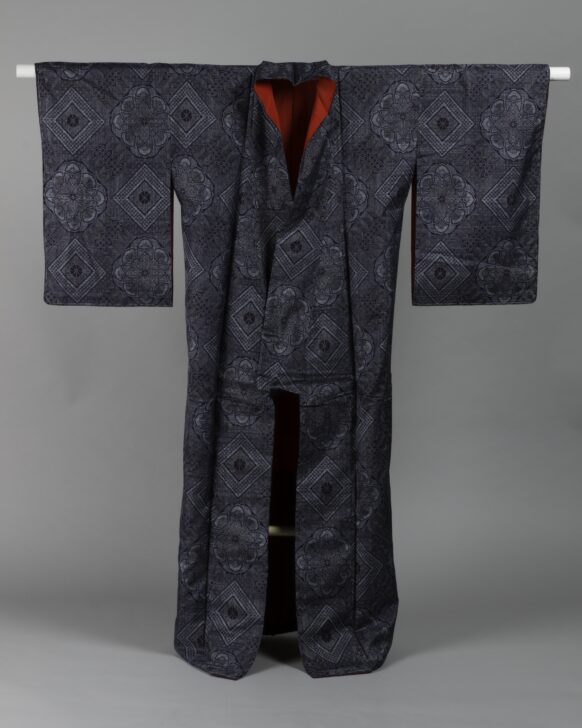Kimono
Japanese

Description
Fashioned in the Amami islands of Japan, Oshima Tsumugi silk has long been admired
for its understated beauty, incredible softness, and comfortable lightness suitable for all
seasons. The fabric is created through a remarkable and laborious process involving
two stages of weaving and over 100 rounds of dyeing. First, white silk threads are
woven to mark and bind patterned area with cotton threads, and then disassembled.
The wefts (horizontal threads) and the warps (vertical threads) are separately dyed with
plant juice, taken from a type of locally grown rose bush, and mud. Mud gives shimmer
and tender texture to the silk. After the cotton binds are removed, and sometimes more
colors are added (see the brown sections of some of the patterns in this kimono), the
wefts and the warps are woven into a final product. The entire process can take up to
one year. Despite the high production values and complexities, however, Oshima
Tsumugi kimono can be worn only for non-ceremonial occasions, since woven fabric is
considered to be a less elevated technique than paint-dyed fabric.
Subject Matter:
Geometric motifs are combination of “Shu Brocade.” Inspired by third-century brocades from the Chinese Kingdom of Shu, these patterns combine octagonal and square motifs. Floral and animal motifs are often incorporated as well.
Ooshima tsumugi silk textiles are made from a labor-intensive process involving two stages of weaving and over 100 rounds of dyeing. Despite its high production value, it is only worn for non-ceremonial occasion since the process is considered to be less elite than the paint-dyed technique.
The inner lining includes eight different parts (hakkake) on the bottom and sleeve edges that gives the inner lining a more colorful appearance.
Physical Description:
Shiny dark indigo Ooshima tsumugi with various interwoven floral geometric motif patterning with a red inner lining.
Usage Rights:
If you are interested in using an image for a publication, please visit https://umma.umich.edu/request-image/ for more information and to fill out the online Image Rights and Reproductions Request Form.